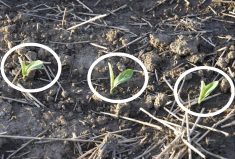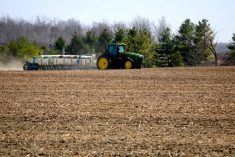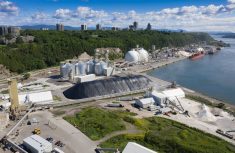Farmers in Ontario grow soybeans that yield about 50 bushels per acre.
Sean Conley, Wisconsin’s state soybean extension specialist, says the yield potential is 120 bushels.
The differences are about the same in the United States and Conley set out to use some large data sets to figure out why.
The answer? Not every field, or part of a field will yield 120 bushels of soybeans. More precise management of soil zones could be the answer to overall higher yield.
Conely’s multi-year project aimed to collect soybean data from farmers across the major soy-producing states in the U.S. Those states produce 30 per cent of the world’s soybeans. He aimed to pool farms with similar soil conditions and water holding capacities to create what he calls a Technology Extrapolation Domain (TED).
Read Also

Senft to step down as CEO of Seeds Canada
Barry Senft, the founding CEO of the five-year-old Seeds Canada organization is stepping down as of January 2026.
He found that there were significant differences in the value of certain production practices depending on the TED.
Why it matters: Corn yields have been trending steadily upwards over the past decade, while soybean yields have been more stagnant.
For example, in what he calls the 1R TED, there was no difference in yield if farmers tilled or planted no-till. However, in TED 4R, there was a couple bushels advantage to tillage.
Conley said at the Southwest Ag Conference (SWAC) that his information, across 7,000 fields, means that when regulators come calling, farmers will have the data to, in some cases, request compensation.
If regulators required no-till practices, then farmers in the 1R and 5R TEDs could understand that it shouldn’t make a difference to yield. However, if a farmer is in the 4R zone, then they’d be justified in asking for compensation.
“What I call this is informed pushback for farmers,” he said.
He also looked at fungicide applications at the R3 growth stage of soybeans and those also showed differences among the areas he examined.
In TED 1R, there was no yield difference, but in TED 5R, there was a four-bushel advantage to the early fungicide application and in TED 4R, a four-to-six bushel advantage.
There is also information relating to planting date, which yielded some surprises.
In TED 1R, 4R and 5R, delaying planting past April 20 meant a half a bushel per day in yield loss.
However in North Dakota, there was no correlation between yield and planting date, which is because in North Dakota, everything relating to yield depends on timely rains in that dry area. If there’s not enough rain or irrigation during pod fill, then there isn’t enough water to get any sort of yield response to planting date.
Conley used the 1R, 4R and 5R zones as examples because he says they are from Wisconsin, and they likely resemble some of the conditions for Ontario growers. He said it would be difficult to describe the zones accurately enough for farmers to assume similar responses in Ontario.
Ontario lacks the soil zone data that is available across the United States, so a similar project would be challenging in Ontario, he said.















